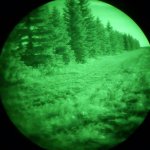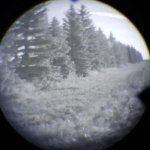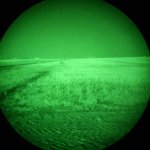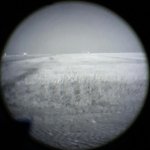Well, every once in a while I like to do night vision comparison, because reasons. So here is the latest installment of my fairly repetitive night vision tests. I just recently received a used Armasight Sirius Gen 2 white phos monocular, so I thought it would be a good one to showcase the differences between expensive and cheap NODs, show white vs green, and the always questioned gen 2 vs 3.
If you're new to night vision, and in particular I2, I would recommend checking out what TV-PressPass has to write on it. He has some pretty neat videos and write ups explaining the differences. Another starting note is I am referring to gen 2 as most would think of gen 2: inferior to gen 3 night vision. This is not exclusively the case, as many new gen 2 devices are comparable to the latest and greatest gen 3; however if you are buying that high of quality gen 2, you know exactly what you are getting, as you are laying down serious coin. Generally those buying gen 2 NOD's are looking for a less expensive (and thus inferior) entry level unit.
So what I have is a PVS-14 with an OMNI VII tube. This means it is autogated (dims when it is bright); has a resolution of 64 lp/mm or greater, and a signal-to-noise ratio of 28 or greater. It has a milspec housing, which is expensive, but durable and has lots of parts/accessories available.
The Armasight Sirius is a Gen 2 'Quick Silver' white phosphor tube, with an approximately 47-54 lp/mm resolution, and a signal-to-noise ratio of 15-22, thought I would guess towards the low end of that. It is a proprietary housing, which is cheap, and is not as easy to find parts/accessories for.
On to the comparisons. First up is just a quick shot inside my shop. Behind me are 2 large transparent doors, letting in the full moon. The biggest thing to note is the difference in viewing angle. The PVS-14 is noticeably greater, with about 45 degrees visible, and all are usable. The Sirius has about 35 degree of viewing, however the last few degrees at the end succumbs to very noticeable fish eye, and is not very usable.


The next image set is along the shelter belt of my yard. On such a clear, full moon night, you can tell that there is not much of a difference between the gen 2 and 3 tubes; there is ample light to see well with either. However, if you start to look into the trees, you can tell that the improved resolution really helps the gen 3 to see a bit more.


This image set really shows the differences in resolution between the high quality gen 3 and the entry level gen 2. Looking at the stubble in the field, it is easy to see the difference. Again, the full moon makes the gen 2 just as usable in terms of light amplification, though.


The next image set I struggled to attach, and CGN says I can only attach 7 per post, so I won't, ha. It is in my warehouse, with only 2 very small sources of moonlight coming in. This is where I can see the gen 3 shining; it is usable where the gen 2 is simply useless. However, cell phone cameras do not pick up on this well enough, so you will have to take my word for it.
The takeaway from this is not necessarily to buy the most expensive NOD that you can. While in the world of night vision you get what you pay for, depending on your needs, the less expensive option can work very well for you. With regards to tube gen if you are just going out and about in the open fields, then almost any night gen 2 will be satisfactory in light amplification and resolution, and on the darkest of nights, a good infrared illuminator will get you the rest of the way. If you are walking in the woods, where not much ambient light gets through, then you would be silly not to buy gen 3.
In the same way, if a device is just going to be rifle mounted, as my Sirius will be, then the limited field of view is not such an issue. If you are walking around with a head mounted unit, I would certainly recommend getting a housing that allows at least 40-45 degrees of view, regardless of tube gen. And as for white phos vs green? It all comes down to personal preference, thought white phos is generally a few hundred more than green.
If you're new to night vision, and in particular I2, I would recommend checking out what TV-PressPass has to write on it. He has some pretty neat videos and write ups explaining the differences. Another starting note is I am referring to gen 2 as most would think of gen 2: inferior to gen 3 night vision. This is not exclusively the case, as many new gen 2 devices are comparable to the latest and greatest gen 3; however if you are buying that high of quality gen 2, you know exactly what you are getting, as you are laying down serious coin. Generally those buying gen 2 NOD's are looking for a less expensive (and thus inferior) entry level unit.
So what I have is a PVS-14 with an OMNI VII tube. This means it is autogated (dims when it is bright); has a resolution of 64 lp/mm or greater, and a signal-to-noise ratio of 28 or greater. It has a milspec housing, which is expensive, but durable and has lots of parts/accessories available.
The Armasight Sirius is a Gen 2 'Quick Silver' white phosphor tube, with an approximately 47-54 lp/mm resolution, and a signal-to-noise ratio of 15-22, thought I would guess towards the low end of that. It is a proprietary housing, which is cheap, and is not as easy to find parts/accessories for.
On to the comparisons. First up is just a quick shot inside my shop. Behind me are 2 large transparent doors, letting in the full moon. The biggest thing to note is the difference in viewing angle. The PVS-14 is noticeably greater, with about 45 degrees visible, and all are usable. The Sirius has about 35 degree of viewing, however the last few degrees at the end succumbs to very noticeable fish eye, and is not very usable.


The next image set is along the shelter belt of my yard. On such a clear, full moon night, you can tell that there is not much of a difference between the gen 2 and 3 tubes; there is ample light to see well with either. However, if you start to look into the trees, you can tell that the improved resolution really helps the gen 3 to see a bit more.


This image set really shows the differences in resolution between the high quality gen 3 and the entry level gen 2. Looking at the stubble in the field, it is easy to see the difference. Again, the full moon makes the gen 2 just as usable in terms of light amplification, though.


The next image set I struggled to attach, and CGN says I can only attach 7 per post, so I won't, ha. It is in my warehouse, with only 2 very small sources of moonlight coming in. This is where I can see the gen 3 shining; it is usable where the gen 2 is simply useless. However, cell phone cameras do not pick up on this well enough, so you will have to take my word for it.
The takeaway from this is not necessarily to buy the most expensive NOD that you can. While in the world of night vision you get what you pay for, depending on your needs, the less expensive option can work very well for you. With regards to tube gen if you are just going out and about in the open fields, then almost any night gen 2 will be satisfactory in light amplification and resolution, and on the darkest of nights, a good infrared illuminator will get you the rest of the way. If you are walking in the woods, where not much ambient light gets through, then you would be silly not to buy gen 3.
In the same way, if a device is just going to be rifle mounted, as my Sirius will be, then the limited field of view is not such an issue. If you are walking around with a head mounted unit, I would certainly recommend getting a housing that allows at least 40-45 degrees of view, regardless of tube gen. And as for white phos vs green? It all comes down to personal preference, thought white phos is generally a few hundred more than green.
Attachments
Last edited:

















































































